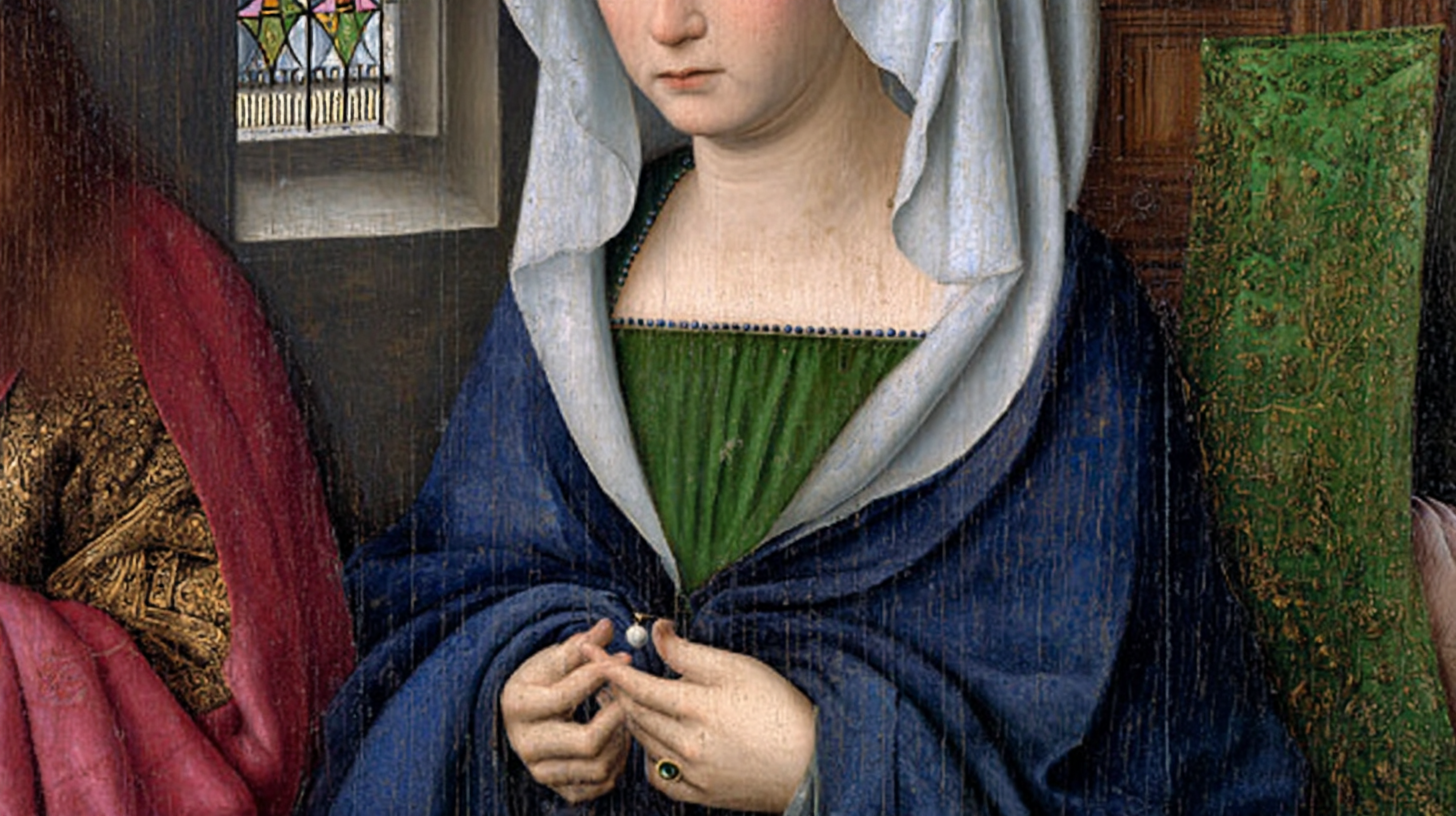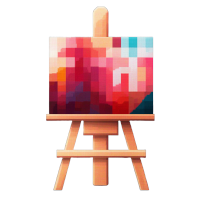Mix Colors Like Jan van Eyck
Table of Contents

Jan van Eyck was a leading figure of the Northern Renaissance, renowned for enamel‑like surfaces and extraordinary clarity. His color comes from carefully layered oil glazes over stable underlayers, with cool, transparent shadows and warm, opaque lights. In this guide, you’ll apply those ideas step by step using period‑correct practice and safe modern substitutes.
In this guide you’ll recreate Jan van Eyck’s luminous, jewel-like surface using period-correct oil practice. We’ll define the historically attested palette, provide exact swatch recipes, and walk a careful glazing workflow suited to panels.
What Defines Jan van Eyck’s Color and Light
- High-contrast modeling with cool, transparent shadows and warm, opaque lights.
- Jewel tones built by stacking thin, high-chroma glazes over stable underlayers.
- Earth neutrals for structure; saturated lakes and blues reserved for accents and drapery.
- Panel support with crisp drawing and enamel-like surface from meticulous layering.
Historically Attested Materials → Optional Modern Equivalents
Core historical pigments, binders, and supports (period-correct)
| Historical name | Role | Modern equivalent | Pigment code(s) | Brand examples | Notes |
|---|---|---|---|---|---|
| Lead White (Cremnitz) | Lights, body | Titanium/Zinc mix | PW6/PW4 | W&N, Gamblin | Period: PW1; modern mix is cooler |
| Lead‑Tin Yellow (Type I/II) | Warm lights, golden cloth | Bismuth Yellow | PY184 | MH, Schmincke | Opaque, warm yellow mass tone |
| Yellow Ochre | Earth yellow midtones | Yellow Ochre | PY43 | W&N, Old Holland | Value control in flesh |
| Vermilion/Cinnabar | Warm red accents | Cadmium Red Light | PR108 | W&N, MH | Strong tinting; use sparingly |
| Madder/Kermes Lake | Transparent red glaze | Quinacridone Red/Magenta | PR122/PR177 | W&N, Gamblin | Period lakes can be fugitive |
| Azurite | Blue underpaint/drapery | Cobalt Blue / Ultramarine | PB28/PB29 | W&N, Rembrandt | Azurite PB30; ultramarine rare but attested |
| Verdigris | Green glazes | Viridian / Phthalo Green | PG18/PG7 | W&N, Rembrandt | Period PG20 can brown; prefer modern |
| Malachite | Green body color | Cobalt Green | PG19 | Holbein, W&N | Soft, low chroma green |
| Bone/Ivory Black | Deep shadows | Ivory Black | PBk9 | W&N, Rembrandt | Transparent, low chroma |
| Burnt Umber | Warm shadow neutral | Burnt Umber | PBr7 | MH, W&N | Fast drying underlayers |
Optional modern safe equivalents (buyable today)
| Historical name | Role | Modern equivalent | Pigment code(s) | Brand examples | Notes |
|---|---|---|---|---|---|
| Lead White | Lights | Titanium/Zinc (mix) | PW6/PW4 | Gamblin, W&N | Slightly cooler; add warm yellow to adjust |
| Lead‑Tin Yellow | Warm light | Bismuth Yellow | PY184 | Schmincke, MH | Clean opaque yellow; good for gold |
| Vermilion | Warm red | Cadmium Red Light | PR108 | W&N, MH | Excellent opacity; powerful tinting |
| Lakes (Madder/Kermes) | Red glazes | Quinacridone Magenta/Red | PR122/PR209/PR177 | Gamblin, W&N | Lightfast glaze substitutes |
| Azurite/Ultramarine | Blues | Ultramarine / Cobalt Blue | PB29/PB28 | Any | Pair with white for underpaints; glaze to enrich |
| Verdigris/Malachite | Greens | Viridian / Phthalo Green | PG18/PG7 | Any | Use thin to avoid over-chroma |
Mediums, Grounds, and Surfaces
- Support: seasoned oak panel with chalk gesso (glue-bound), sanded smooth.
- Imprimatura: very thin warm neutral wiped to a mid-light value; mix 4 parts Yellow Ochre (PY43) + 2 parts Burnt Umber (PBr7) + 0.25 parts Ivory Black (PBk9). Dilute with odorless mineral spirits (OMS) at 1:2 paint:OMS to an ink-like wash that wipes cleanly; keeps the panel from glaring.
- Binder/medium (period-correct): drying oil (linseed; walnut for pale passages). Glazes built with oil only; avoid resin-laden mixtures unless specifically required by your process knowledge.
- Drying behavior: underlayers lean and thin; lights have more body; glazes extremely thin and controlled. Allow thorough set between layers.
- Optional modern handling: tiny amounts of stand oil or an alkyd medium can improve flow; stay consistent and keep layers thin.
Value Design and Lighting Setup
- Single dominant light from above-front; keep backgrounds low-chroma and mid-dark to frame the lights.
- Target values: background V2–V4, flesh lights up to V8–V9, darks anchored near V2.
- Reserve highest chroma (lakes, blues, greens) for focal textiles and accents.
Recipes — Swatches and Ratios (Period-Correct)
Value (V) runs from V1 (darkest) to V9 (lightest). Ratios are by volume on the palette.
All recipe formulas below use modern-safe pigments (historical materials are discussed above for context).
| Target color | Use case | Recipe (parts by volume) | Value | Notes |
|---|---|---|---|---|
| Pale flesh light (cool) | Forehead/cheek planes | 6 parts Titanium/Zinc White (PW6/PW4) + 0.75 parts Bismuth Yellow (PY184) + 0.25 parts Cadmium Red Light (PR108) | V8–V9 | Warm with PY184; cool with a trace Bone Black (PBk9) |
| Half‑tone flesh (warm) | Transition planes | 2 parts Yellow Ochre (PY43) + 1 part Cadmium Red Light (PR108) + 1 part Titanium/Zinc White (PW6/PW4) | V6 | Keep opaque; glaze lakes later for bloom. When studying van Eyck's portraits, you can extract precise flesh tone color palettes from your reference photos to compare with these historical formulas |
| Deep shadow neutral | Form shadow bed | 3 parts Bone Black (PBk9) + 1 part Burnt Umber (PBr7) | V2 | Very thin; wipe to unify |
| Blue drapery underpaint | Base for ultramarine glaze | 2 parts Ultramarine Blue (PB29) + 1 part Titanium/Zinc White (PW6/PW4) | V5 | Build hue with later transparent blue glaze |
| Red glaze over cadmium body | Saturated cloth accents | 1 part Cadmium Red Light (PR108) body + very thin Quinacridone Magenta (PR122) glaze | V4–V6 | Body first; glaze when set |
| Green glaze for foliage/cloth | Transparent green accents | 1 part Viridian (PG18) very thin over Yellow Ochre (PY43) body | V4–V6 | Keep extremely thin to prevent bronzing |
| Background warm brown | Architectural field | 2 parts Burnt Umber (PBr7) + 1 part Yellow Ochre (PY43) + 0.25 parts Bone Black (PBk9) | V3–V4 | Low chroma; preserves focus |
Step-by-Step Workflow
Underlayer and drawing
- Prepare a smooth chalk gesso panel; tone with a wiped warm imprimatura to mid‑light.
- Establish drawing with a small rounded brush using a thin Ivory Black (PBk9) 3 parts + Burnt Umber (PBr7) 1 part mix (3:1). Dilute with OMS at 1:2 paint:OMS to a skim‑milk thin, fast-evaporating wash.
Establish shadow family
- Lay in form shadows with Bone Black (PBk9) + Burnt Umber (PBr7); keep mixtures thin and even.
- Soften edges into the imprimatura; leave lights largely unpainted at first.
Midtones and lights
- Build midtones with Yellow Ochre (PY43) and adjust toward light with Titanium/Zinc White (PW6/PW4) and hints of Bismuth Yellow (PY184). For foundational principles on understanding color mixing in oil painting, see our comprehensive guide on color theory.
- Reserve the highest values for final passes; keep lights thicker than shadows but not paste‑like.
Color enrichment and accents
- When underlayers are set, enrich textiles: body color (e.g., Cadmium Red Light (PR108), Ultramarine (PB29)) first, then extremely thin quinacridone/blue glazes to push chroma.
- Add specular accents sparingly with near‑pure Titanium White (PW6) or Titanium/Zinc White (PW6/PW4); control edge sharpness.
Unify with glazes
- Apply very thin, controlled glazes (lakes, verdigris, ultramarine where appropriate) to unify passages and adjust hue/value. Let each glaze set fully.
Troubleshooting and Pitfalls
- Chalky lights: reduce Lead White proportion; warm slightly with Lead‑Tin Yellow; consider an ultra‑thin glaze to unify.
- Muddy midtones: keep warm/cool piles separate; avoid overmixing across complements; glaze for chroma instead of over‑tinting. For deeper understanding of mastering color theory for oil painters, review our tutorial on preventing muddy colors through proper color relationships.
- Dead shadows: increase transparency; rely on Ivory Black (PBk9) + Burnt Umber (PBr7) mixes; wipe back and re‑glaze rather than piling opaque paint.
Get your color palette from your reference photo
Upload your reference image and get instant, accurate oil paint color recipes based on your palette.
